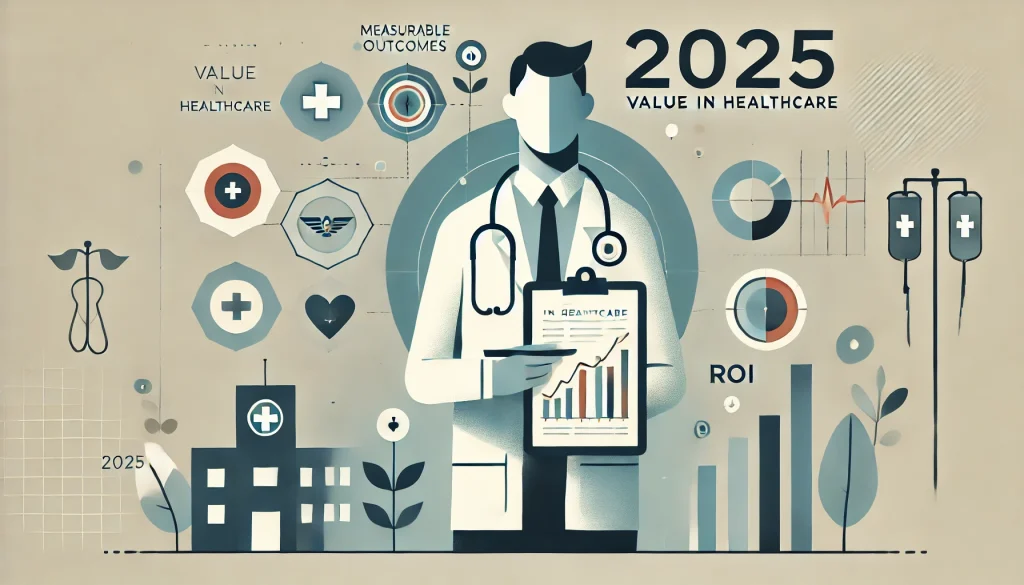Unlocking the True Value in Healthcare: A Framework for Measurable Impact

Medvale – February 21, 2025 In healthcare, “value” is often cited as a central goal, but what does it really mean? Why is it so hard to measure, and more importantly, how do we effectively buy and sell healthcare solutions while ensuring tangible value? Here’s a framework based on insights shared in a recent Medvale Lyceum with Craig Solid, founder of Solid Research Group, to help navigate these complex discussions and make value more tangible for healthcare providers, buyers, and stakeholders. Key Questions to Assess Healthcare Value What Are You Measuring? Start by identifying what specific aspects of value you are aiming to measure. Is it patient outcomes, cost savings, or something else entirely? Being clear on what value means in your context is essential for meaningful analysis. To Whom is the Value Measured? Understand that value is subjective. Who benefits from the intervention? A quality improvement that increases patient satisfaction may not yield immediate financial ROI but could reduce turnover and improve long-term patient loyalty. Is Value Quantifiable? While some components of value are easily measurable (e.g., cost per outcome), others, like emotional well-being or caregiver satisfaction, are more challenging to quantify. Focus on measurable outcomes like ROI, time saved, or reduced adverse events. Want to dive deeper into this topic? Click here to listen to listen to the entire session from our recent Medvale Lyceum with Craig Solid moderated by Jim Trounon, where they explore these concepts in more detail and offer actionable insights. Practical Steps for Sellers: How to Present Healthcare Value Know Your Buyer’s Value Framework Understand the specific metrics and outcomes that matter to the buyer. Different stakeholders—hospital administrators, payers, or providers—will have different priorities when it comes to defining value. Tailor your pitch accordingly. Use Behavioral Insights to Craft Your Message People’s decisions are influenced by biases and subjective experiences. When presenting the value of your product or service, anticipate and address potential biases, such as confirmation bias or the status quo bias, that could affect how it’s received. Go Beyond Financials: Highlight Non-Monetary Benefits Value isn’t only about money. Consider non-monetary benefits like staff well-being or better patient access. These can be powerful selling points when framed effectively. Practical Steps for Buyers: How to Assess Healthcare Value Look Beyond Quality per Dollar A common mistake in healthcare is reducing value to a simple equation of “quality per dollar spent.” Consider broader metrics like long-term patient satisfaction, staff engagement, and clinical outcomes. Think Holistically About Value Assess how a solution fits into the larger system, taking into account its impact on workflow, culture, and overall organizational goals. Sometimes the highest ROI isn’t immediately financial but can emerge over time through improved systems and relationships. Account for Uncertainty and Variability When evaluating value, don’t settle on a single metric or estimate. Acknowledge the inherent uncertainty in healthcare solutions. Consider best- and worst-case scenarios to account for potential risks and variability in outcomes. Conclusion: Starting the Value Conversation Early For both buyers and sellers, the key to navigating healthcare value is starting the conversation early. In the case of healthcare startups, thinking about value from the design phase can help avoid costly misalignments later. By defining clear parameters—who benefits, how it’s measured, and over what timeline—you can ensure your value proposition aligns with the needs of healthcare providers and consumers alike.
Rebuilding Trust in Healthcare: Where Do We Start?

Medvale – February 21, 2025 Trust has always been the foundation of healthcare. Patients rely on their doctors to guide them, physicians trust the system to support them, and organizations are expected to act in the best interest of those they serve. But something has changed. Trust is eroding—among patients, providers, and institutions alike. In a recent Megaphone episode, Medvalista Tom Ferkovic sat down with Dave Self to unpack the deeper issues driving this breakdown and explore what it would take to restore confidence in the system. 🎙️ Click here to listen to the full conversation. One of the key insights from their discussion? Healthcare isn’t just broken—it’s buried under layers of complexity that make trust nearly impossible. Administrative overload, rigid regulations, and financial incentives misaligned with patient care have created a system that feels more like an obstacle course than a place of healing. Ferkovic argues that real change won’t come from tweaking policies at the edges—it requires “opening the code” of healthcare, much like Apple did when it unleashed app development to innovators. But right now, that code is locked behind insurers, EHR giants, and bureaucratic red tape. So, where do we start? Ferkovic emphasizes that rebuilding trust means cutting through the noise and taking action. Medvale, as a peer-driven community, can be a space where healthcare leaders challenge each other, share unfiltered insights, and push for real solutions. If the system won’t change itself, those working within it need to take the lead.
Tackling Physician Burnout: A Transformative Approach at St. Luke’s Health System

Medvale – January 21, 2025 Physician burnout remains one of the most pressing issues in healthcare today, affecting not only the well-being of physicians but also the quality of care provided to patients. At St. Luke’s Health System, a bold initiative led by Jim Souza, MD and Katie Schneider, MD, has proven to be a game-changer, significantly reducing burnout and fostering a more supportive, efficient healthcare environment. The Importance of Well-Being in Healthcare St. Luke’s Health System, a nonprofit organization based in Boise, Idaho, recognizes that the well-being of healthcare providers is inextricably linked to organizational performance. In an industry focused on delivering human-centered care, the health of those providing care plays a pivotal role in improving patient outcomes. Burned-out teams are more prone to safety issues, lower patient satisfaction, and higher costs, making the need to address physician burnout a top priority. The Catalyst for Change The journey to combat physician burnout at St. Luke’s began in 2016 when the tragic suicide of a physician sparked a community-wide conversation. The leadership team recognized the urgent need for systemic change and brought in expert Paul DeChant MD, whose insights served as a powerful catalyst for action. This conversation led to the establishment of a comprehensive well-being program that would not only target burnout but also foster a culture of wellness within the organization. Creating a Supportive Infrastructure At the heart of this initiative is the recognition that tackling burnout requires top-level leadership visibility and prioritization. St. Luke’s made a bold decision to position the program directly under the Chief Physician, ensuring that well-being was not just a secondary concern but a core value. A key component of the strategy was the creation of a “Center of Excellence” for well-being, which would serve as a resource to inform and guide the entire organization, ensuring that the well-being of staff was seen as everyone’s responsibility. Want to learn more? Click here to watch the full Medvale Lyceum featuring Jim Souza, MD and Katie Schneider, MD, moderated by Paul DeChant, MD, as they dive deeper into the strategies for reducing burnout and fostering well-being in healthcare. Wellness-Centered Leadership One of the pivotal strategies in reducing burnout at St. Luke’s was the implementation of wellness-centered leadership. Dr. Katie Schneider, a family physician and certified coach, led efforts to train senior leadership and medical directors in evidence-based practices for reducing burnout and increasing job satisfaction. The leadership training program emphasized the importance of empathy, communication, and creating an environment where physicians felt valued. In addition to leadership training, St. Luke’s implemented an annual survey to gauge physician well-being and identify areas for improvement. Participation rates rose significantly, and the data collected allowed for targeted interventions, including workshops and wellness programs designed to address the specific drivers of burnout. Tangible Results The impact of St. Luke’s commitment to physician well-being has been profound. Since the program’s inception, burnout rates have decreased from nearly 55% to under 35%. Similarly, feelings of being valued among physicians have risen, and leadership alignment has improved across all levels of the organization. Perhaps most importantly, physician retention has significantly improved. The intent to leave has decreased from 40% to 25%, a clear indicator that the well-being program has had a stabilizing effect on the workforce. This reduction in turnover has translated into reduced recruiting costs and, importantly, better care for patients. Looking Ahead While St. Luke’s Health System has made significant strides in reducing burnout, the work is far from over. The organization is focused on enhancing practice efficiency through innovations like AI scribe technology, which helps alleviate administrative burdens on physicians, allowing them to focus more on patient care. As St. Luke’s continues to evolve, the organization remains committed to maintaining a strong culture of well-being and ensuring that all staff, from leadership to frontline providers, have the support they need to thrive. Key Takeaways Invest in Leadership: A commitment to wellness-centered leadership is one of the most effective ways to reduce burnout and improve team morale. Use Data to Drive Change: Regular surveys and data analysis provide critical insights into the factors contributing to burnout, enabling targeted interventions. Create a Supportive Environment: Peer support, wellness programs, and access to mental health resources are essential for helping physicians and staff manage stress and maintain their well-being. Consistency is Key: Staying focused on a long-term strategy and not veering from it is crucial to achieving sustained improvements in well-being. Measure Success: Tracking metrics like burnout rates, leadership alignment, and retention rates can help quantify the success of wellness initiatives and guide future efforts. St. Luke’s Health System’s approach to addressing physician burnout provides a model for healthcare organizations looking to create a healthier, more sustainable workforce. By investing in their people, St. Luke’s is not only improving the lives of their physicians but also delivering better care for their patients.
Navigating Uncertainty in Healthcare: Preparing for 2025 and Beyond

Medvale – December 21, 2024 As we approach 2025, the healthcare industry is bracing for a wave of regulatory, financial, and operational changes, all shaped by the aftermath of the latest political developments. In a recent panel, experts shared their insights on the shifting terrain and what healthcare leaders should focus on in the coming years. The Impact of Policy and Regulation The biggest concern across health systems, particularly post-election, revolves around funding cuts and new strategies aimed at saving money. As discussed by Ken Segel, CEO of Value Capture, while healthcare may not be the immediate priority of the administration, shifts in government spending and regulatory adjustments will deeply affect the industry. One key issue is the potential cuts in Medicaid and changes in Medicare Advantage. The repercussions could be substantial, especially in terms of revenue models, with the likelihood of some programs transitioning to block grants and others seeing adjustments in their subsidies. However, the biggest regulatory shift that health systems need to be prepared for is the push towards value-based care. With the aim of controlling healthcare costs while improving patient outcomes, the transition from fee-for-service to value-based models will continue to be a hot topic, and healthcare providers must strategize to ensure they meet these new expectations. Want to dive deeper into these topics and hear more from healthcare industry experts? Click here to watch to the Medvale Flash Lyceum, where we explored the most pressing issues and innovative strategies shaping the future of healthcare. The Financial Shift: Opportunities in Dealmaking On the financial front, the panel discussed the thawing capital markets and the expected surge in dealmaking for healthcare businesses, particularly with private equity firms eager to invest. Neil Johnson, managing partner at Lawrence Evans & Company, emphasized the availability of capital but noted that valuations have become more volatile. The wave of deregulation is anticipated to spark further consolidation in the healthcare sector. For smaller practices, particularly those in rural areas or offering specialized services, the need to adapt to these trends and explore strategic partnerships is more critical than ever. For independent healthcare providers, such as Wade Erickson, MD, of Medical Network of Alaska, understanding the shifting contracting models and keeping an eye on new opportunities in Medicare Advantage will be key. In the face of challenges like workforce shortages and labor inflation, Wade’s focus is on leveraging value-based contracting as a way to raise revenue while adapting to the changing healthcare landscape. Innovation and Emerging Threats The discussion also touched on the growing role of innovation in healthcare. One area seeing rapid development is in the use of GLP-1 medications, which have shown promise not only in treating diabetes but also in addressing obesity, heart disease, and possibly even Alzheimer’s. While these drugs could revolutionize treatment, their high costs present a major challenge for healthcare systems and insurance providers. How these treatments are integrated into healthcare reimbursement systems—particularly in value-based care models—remains to be seen. However, not all advancements are without risk. Harry Leider, a former CMO at Walgreens, raised concerns about the erosion of trust in science, especially in the face of potential regulatory rollbacks. The panel agreed that while deregulation could boost business, it carries the risk of compromising patient safety, as evidenced by the infamous Theranos case, which shook the foundations of medical technology and regulatory oversight. Looking Ahead: Strategic Considerations for Healthcare Leaders As healthcare leaders and executives look ahead, it’s clear that 2025 will be a year to navigate uncertainty. From managing regulatory changes and evaluating new reimbursement models to embracing the role of innovation while managing costs, healthcare providers need to stay ahead of the curve. The focus on operational excellence, primary care, and preventative measures will be essential for thriving in a rapidly evolving industry. For those in the healthcare industry, now is the time to refine business plans, prepare for potential regulatory shifts, and explore new opportunities to ensure sustainability and growth. Watch now for expert insights, forward-thinking discussions, and actionable takeaways to navigate what’s next!